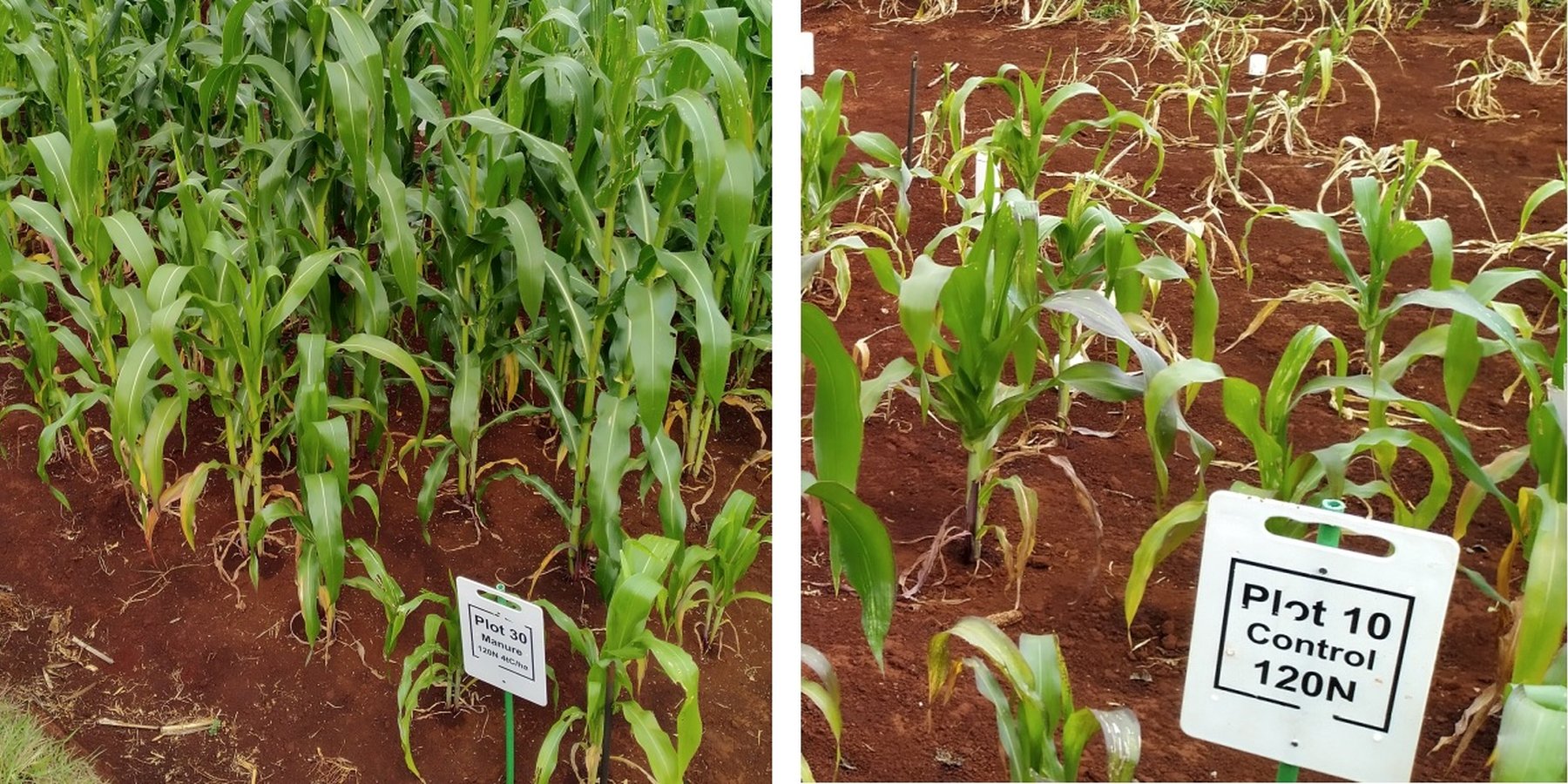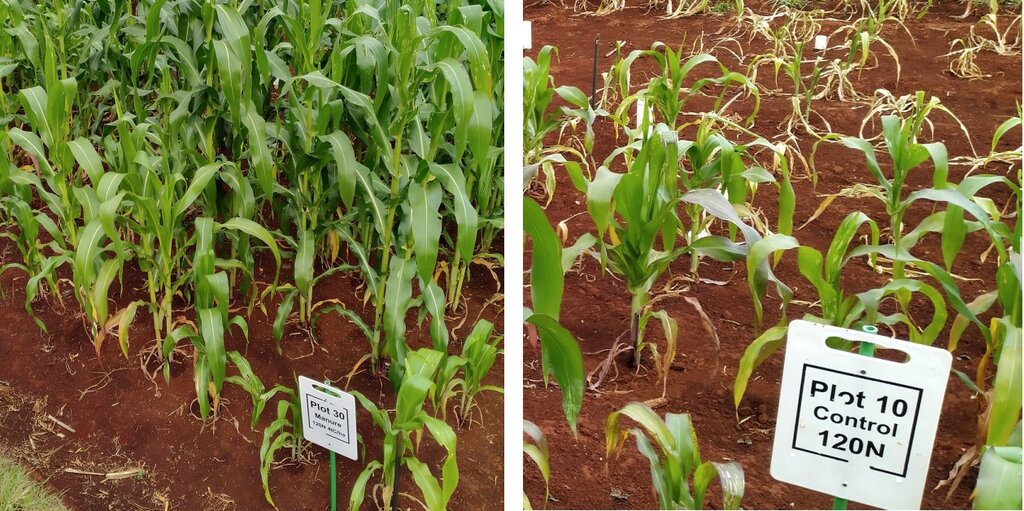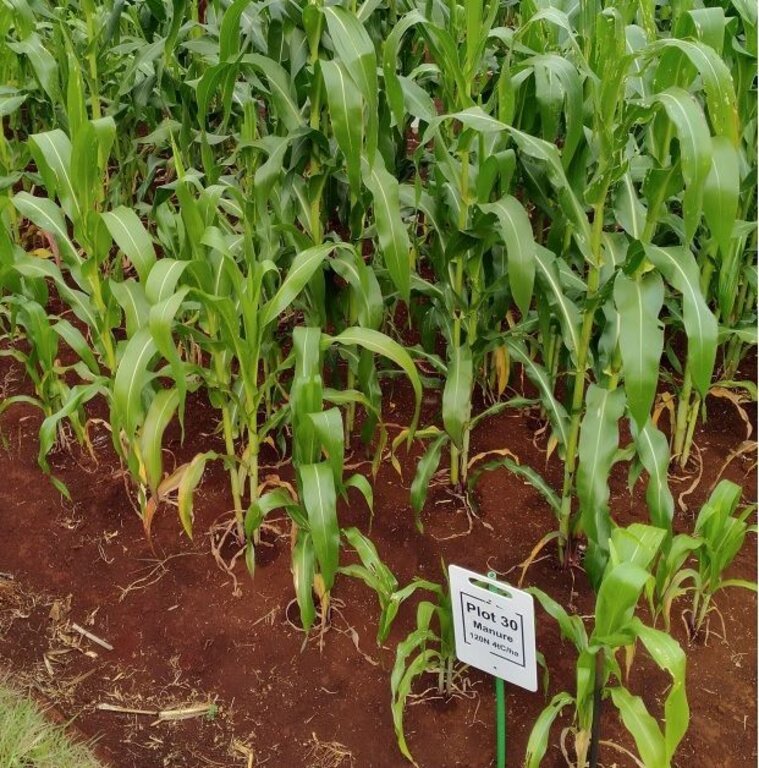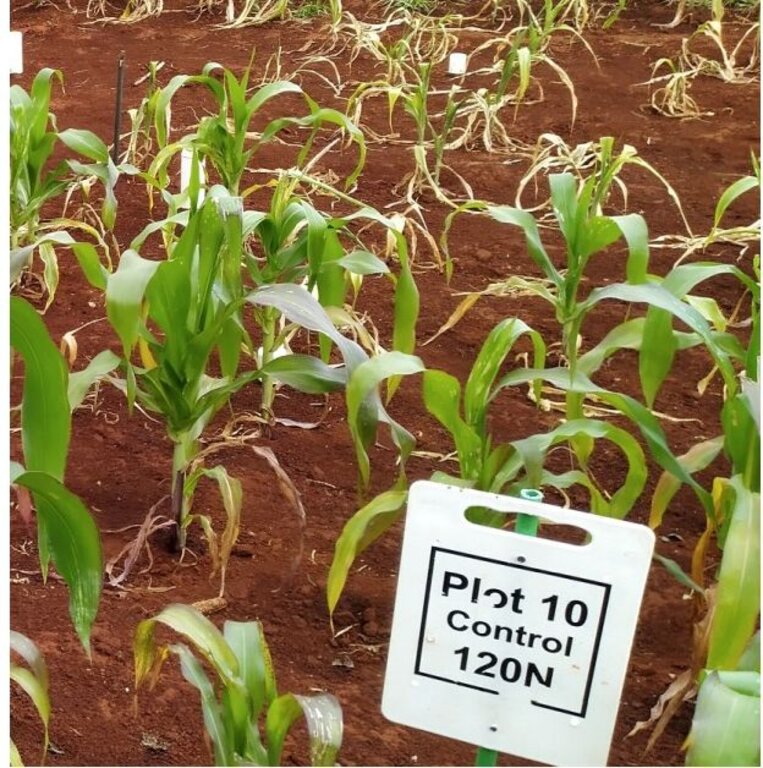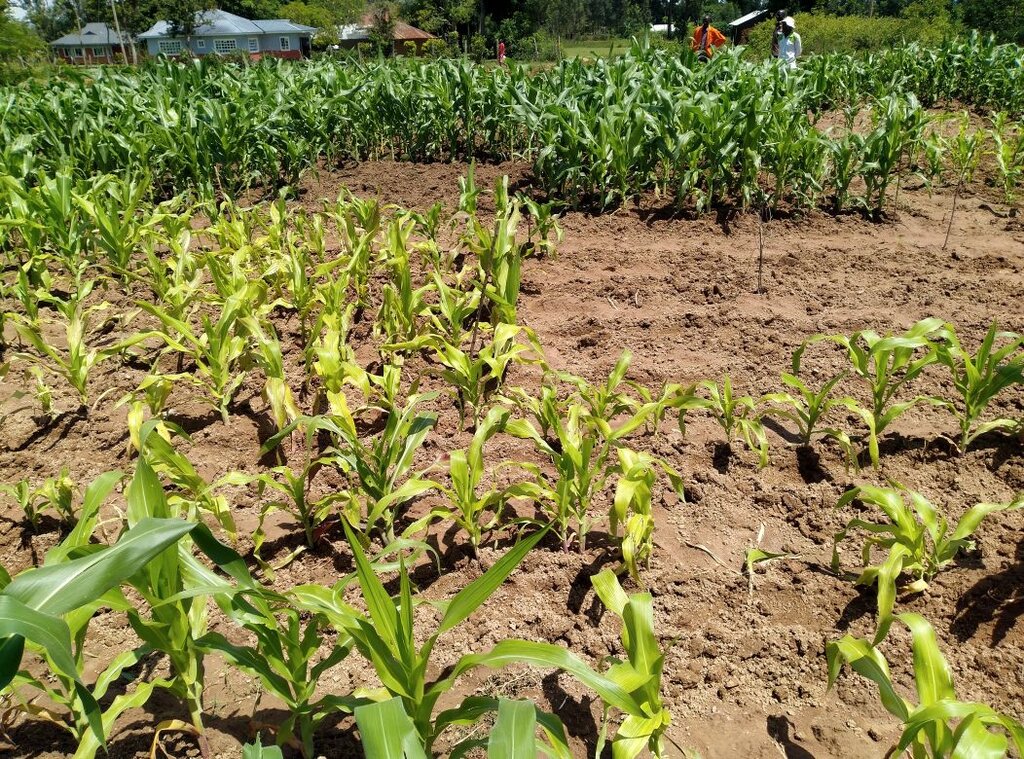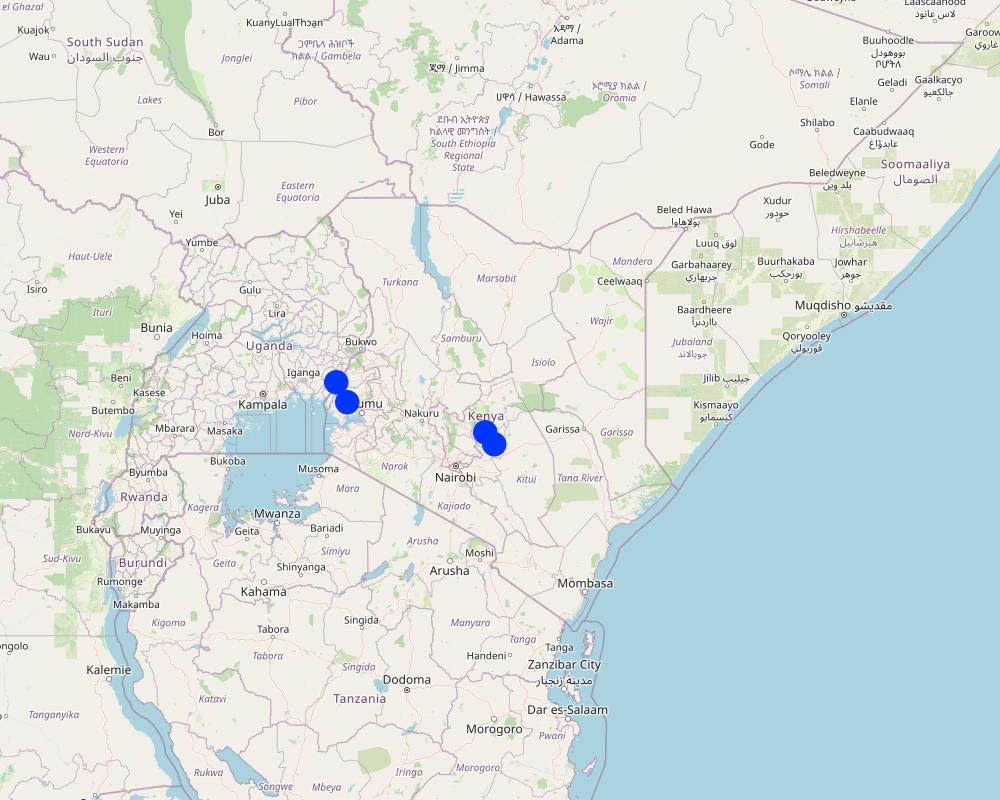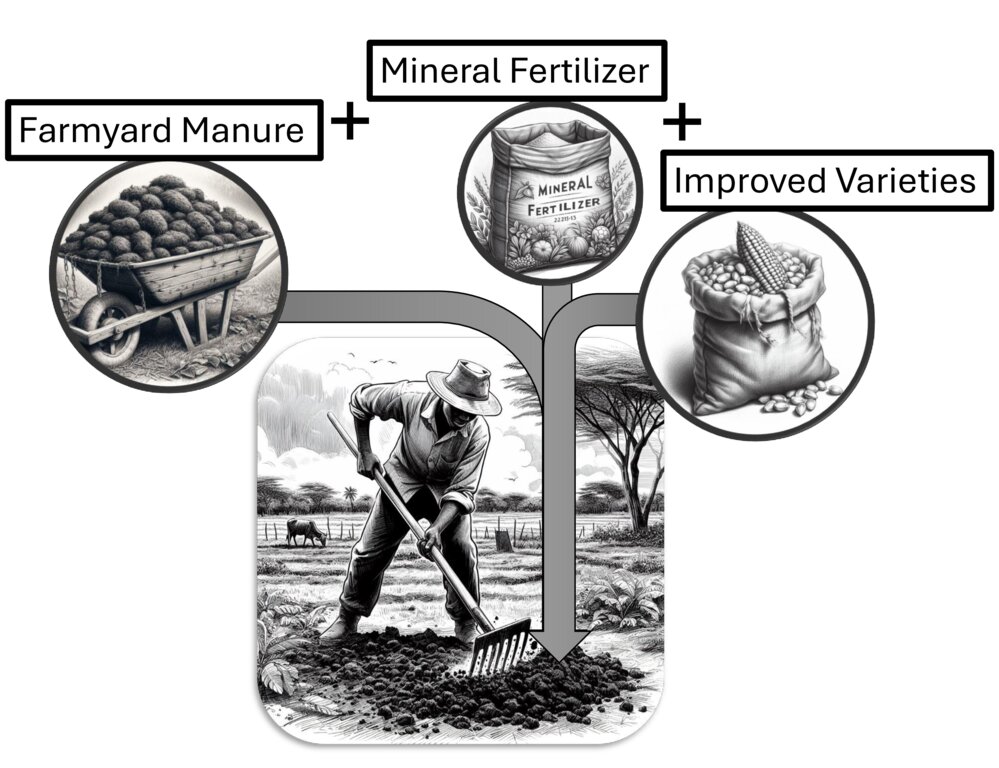Integrated soil fertility management (ISFM) [Kenya]
- Creation:
- Update:
- Compiler: Moritz Laub
- Editor: –
- Reviewers: William Critchley, Rima Mekdaschi Studer
Machanganyiko ya mbolea ya ngombe na fertilizer
technologies_7121 - Kenya
View sections
Expand all Collapse all1. General information
1.2 Contact details of resource persons and institutions involved in the assessment and documentation of the Technology
Key resource person(s)
SLM specialist:
Laub Moritz
ETH Zurich
Switzerland
SLM specialist:
Bernhard Vanlauwe
International Institute of Tropical Agriculture
Kenya
SLM specialist:
Six Johan
ETH Zurich
Switzerland
SLM specialist:
Mucheru-Muna Monicah
Kenyatta University
Kenya
SLM specialist:
Yegon Rebecca
University of Embu
Kenya
land user:
Waswa Wycliffe
International Institute of Tropical Agriculture
Kenya
land user:
Kiragu Silas
University of Embu
Kenya
Name of project which facilitated the documentation/ evaluation of the Technology (if relevant)
Land Use Based Mitigation for Resilient Climate Pathways (LANDMARC)Name of the institution(s) which facilitated the documentation/ evaluation of the Technology (if relevant)
ETH-Zürich (ETH-Zürich) - Switzerland1.3 Conditions regarding the use of data documented through WOCAT
The compiler and key resource person(s) accept the conditions regarding the use of data documented through WOCAT:
Ja
1.4 Declaration on sustainability of the described Technology
Is the Technology described here problematic with regard to land degradation, so that it cannot be declared a sustainable land management technology?
Nee
Comments:
ISFM offers reduced degradation, or even avoided degradation of soils compared to the locally most used alternative maize growing systems, traditional low-input maize production and high input maize production with only mineral N fertilizer. As demonstrated in four long-term trials, both of these systems usually come at the cost of soil fertility loss.
2. Description of the SLM Technology
2.1 Short description of the Technology
Definition of the Technology:
Integrated soil fertility management constitutes a group of management practices aimed at increasing soil fertility and crop productivity with the local context in mind. These practices integrate the use of organic inputs, fertilizers, and better quality seeds with all inputs managed following good farming practices.
2.2 Detailed description of the Technology
Description:
Integrated Soil Fertility Management (ISFM) is applied in arable cropping systems. In this example it was rigorously tested in maize cropping systems in Kenya. The main features of ISFM are the integration of organic inputs to increase or maintain soil fertility and provide a background of nutrient release, with mineral fertilizers to meet peak plant demand together with high quality seeds that can utilize the inputs well. The main objectives are to increase crop yield while maintaining or improving soil fertility. This is important because four long-term trials in Kenya have shown that long-term maize yields decline in both low-input systems and systems with high mineral N inputs but without organic inputs. In contrast, systems with farmyard manure application maintained yields over two decades and maintained significantly higher soil fertility. It has also been shown that the input of organic resources with a low C:N ratio, such as farmyard manure, is more effective in maintaining yields and soil fertility than mineral fertilizer inputs. Thus, the main inputs are organic resources with a low C:N ratio (ideally farmyard manure, but green manures such as Tithonia sp. or Calliandra sp. can also be used), while mineral fertilizers and high quality seeds are also needed. A major activity is the incorporation of organic resources before planting, which requires additional labour. ISFM offers significantly higher yields, and yield maintenance over time, while maintaining or increasing soil fertility. However, it is important to note that the advantage of ISFM over mineral fertilizer use becomes apparent only in the long term (e.g., after 5 to 10 years of continuous cropping). This is because mineral fertilizer inputs may initially mask the loss of soil fertility. This long-term perspective has to be kept in mind when considering the main perceived disadvantage of ISFM - that is the need for manure input and labour for its incorporation, which does not immediately result in higher yields compared to mineral fertilizer application alone.
2.3 Photos of the Technology
2.5 Country/ region/ locations where the Technology has been applied and which are covered by this assessment
Country:
Kenya
Region/ State/ Province:
Embu County; Siaya County; Busia County
Further specification of location:
Embu city; Mavuria; close to Siaya; close to Busia
Specify the spread of the Technology:
- applied at specific points/ concentrated on a small area
Is/are the technology site(s) located in a permanently protected area?
Nee
Comments:
The locations display the position of the long-term trials in which ISFM was tested
Map
×2.6 Date of implementation
Indicate year of implementation:
2002
2.7 Introduction of the Technology
Specify how the Technology was introduced:
- during experiments/ research
3. Classification of the SLM Technology
3.1 Main purpose(s) of the Technology
- improve production
- reduce, prevent, restore land degradation
- adapt to climate change/ extremes and its impacts
- create beneficial economic impact
3.2 Current land use type(s) where the Technology is applied
Land use mixed within the same land unit:
Nee

Cropland
- Annual cropping
Annual cropping - Specify crops:
- cereals - maize
- cereals - millet
- cereals - sorghum
Annual cropping system:
Continuous maize/sorghum/millet
Number of growing seasons per year:
- 2
Is intercropping practiced?
Nee
Is crop rotation practiced?
Nee

Other
Specify:
Mixed crop-livestock farms
Remarks:
Manure can come from animals that are grazed or from animals kept in a zero-grazing system.
3.3 Has land use changed due to the implementation of the Technology?
Has land use changed due to the implementation of the Technology?
- No (Continue with question 3.4)
3.4 Water supply
Water supply for the land on which the Technology is applied:
- rainfed
3.5 SLM group to which the Technology belongs
- integrated crop-livestock management
- integrated soil fertility management
- improved plant varieties/ animal breeds
3.6 SLM measures comprising the Technology

agronomic measures
- A2: Organic matter/ soil fertility
- A5: Seed management, improved varieties
- A6: Residue management
A6: Specify residue management:
A 6.2: grazed
3.7 Main types of land degradation addressed by the Technology

chemical soil deterioration
- Cn: fertility decline and reduced organic matter content (not caused by erosion)

biological degradation
- Bl: loss of soil life
3.8 Prevention, reduction, or restoration of land degradation
Specify the goal of the Technology with regard to land degradation:
- prevent land degradation
- reduce land degradation
4. Technical specifications, implementation activities, inputs, and costs
4.1 Technical drawing of the Technology
Technical specifications (related to technical drawing):
Organic resources are distributed equally across the field and then incorporated (usually by hand hoe). Full ISFM integrates this with improved maize varieties and small doses of mineral fertilizer.
Author:
Moritz Laub
Date:
07/05/2024
4.2 General information regarding the calculation of inputs and costs
Specify how costs and inputs were calculated:
- per Technology area
Indicate size and area unit:
hectare
other/ national currency (specify):
KSH
If relevant, indicate exchange rate from USD to local currency (e.g. 1 USD = 79.9 Brazilian Real): 1 USD =:
135.0
Indicate average wage cost of hired labour per day:
500
4.3 Establishment activities
| Activity | Timing (season) | |
|---|---|---|
| 1. | Training on (green/farmyard) manure handling and incorporation | any |
4.4 Costs and inputs needed for establishment
| Specify input | Unit | Quantity | Costs per Unit | Total costs per input | % of costs borne by land users | |
|---|---|---|---|---|---|---|
| Other | Training on ISFM and organic resource management |
If land user bore less than 100% of costs, indicate who covered the remaining costs:
One or two days of workshop costs. Cost of exchanges with extension agents (mainly time)
4.5 Maintenance/ recurrent activities
| Activity | Timing/ frequency | |
|---|---|---|
| 1. | Organic resource preparation (e.g. chopping of green manure, farmyard manure management) | Before planting |
| 2. | Organic resource application and incorporation to about 15 cm soil depth | Before planting |
| 3. | Application of mineral fertilizer | During peak demand |
4.6 Costs and inputs needed for maintenance/ recurrent activities (per year)
| Specify input | Unit | Quantity | Costs per Unit | Total costs per input | % of costs borne by land users | |
|---|---|---|---|---|---|---|
| Labour | Manual labor for manure incorporation | labor days per ha | 10.0 | 500.0 | 5000.0 | |
| Plant material | Hybrid maize seeds | kg per ha | 25.0 | 450.0 | 11250.0 | |
| Fertilizers and biocides | Manure (green/farmyard) per ha and season | t dry matter | 2.0 | 5500.0 | 11000.0 | |
| Fertilizers and biocides | Mineral N (estimate ideal input) | kg per ha and season | 30.0 | 300.0 | 9000.0 | |
| Total costs for maintenance of the Technology | 36250.0 | |||||
| Total costs for maintenance of the Technology in USD | 268.52 | |||||
Comments:
Prices of May 2024. The cost of manure is highly variable locally (estimated to be around 2000 KSH per t dry matter in western and up to 9000 KSH per t dry matter in central Kenya; we used the mean value of these). In mixed crop-livestock systems, the manure may be sourced from the own farm, in which case the cost of ISFM may be reduced tremendously.
4.7 Most important factors affecting the costs
Describe the most determinate factors affecting the costs:
Local labor prices. Local availability of livestock. Local fertilizer and seed prices.
5. Natural and human environment
5.1 Climate
Annual rainfall
- < 250 mm
- 251-500 mm
- 501-750 mm
- 751-1,000 mm
- 1,001-1,500 mm
- 1,501-2,000 mm
- 2,001-3,000 mm
- 3,001-4,000 mm
- > 4,000 mm
Specifications/ comments on rainfall:
ISFM can likely be used wherever it is feasible to grow maize. It proved most effective in high-rainfall areas > 1200 mm (for maize), because in areas where rainfall was limiting (e.g., Machanga site), the plants were mainly water limited and could not make good use of the additional soil fertility.
Agro-climatic zone
- humid
5.2 Topography
Slopes on average:
- flat (0-2%)
- gentle (3-5%)
- moderate (6-10%)
- rolling (11-15%)
- hilly (16-30%)
- steep (31-60%)
- very steep (>60%)
Landforms:
- plateau/plains
- ridges
- mountain slopes
- hill slopes
- footslopes
- valley floors
Altitudinal zone:
- 0-100 m a.s.l.
- 101-500 m a.s.l.
- 501-1,000 m a.s.l.
- 1,001-1,500 m a.s.l.
- 1,501-2,000 m a.s.l.
- 2,001-2,500 m a.s.l.
- 2,501-3,000 m a.s.l.
- 3,001-4,000 m a.s.l.
- > 4,000 m a.s.l.
Indicate if the Technology is specifically applied in:
- not relevant
5.3 Soils
Soil depth on average:
- very shallow (0-20 cm)
- shallow (21-50 cm)
- moderately deep (51-80 cm)
- deep (81-120 cm)
- very deep (> 120 cm)
Soil texture (topsoil):
- medium (loamy, silty)
- fine/ heavy (clay)
Soil texture (> 20 cm below surface):
- medium (loamy, silty)
- fine/ heavy (clay)
Topsoil organic matter:
- medium (1-3%)
- low (<1%)
If available, attach full soil description or specify the available information, e.g. soil type, soil PH/ acidity, Cation Exchange Capacity, nitrogen, salinity etc.
Detailed descriptions can be found here: https://www.sciencedirect.com/science/article/pii/S0378429022003598
and here: https://soil.copernicus.org/articles/9/301/2023/
5.4 Water availability and quality
Availability of surface water:
medium
Water quality (untreated):
for agricultural use only (irrigation)
Water quality refers to:
surface water
Is water salinity a problem?
Nee
Is flooding of the area occurring?
Nee
5.5 Biodiversity
Species diversity:
- medium
Habitat diversity:
- medium
5.6 Characteristics of land users applying the Technology
Sedentary or nomadic:
- Sedentary
Market orientation of production system:
- mixed (subsistence/ commercial)
Off-farm income:
- less than 10% of all income
Relative level of wealth:
- poor
- average
Individuals or groups:
- individual/ household
Level of mechanization:
- manual work
- animal traction
Age of land users:
- middle-aged
5.7 Average area of land used by land users applying the Technology
- < 0.5 ha
- 0.5-1 ha
- 1-2 ha
- 2-5 ha
- 5-15 ha
- 15-50 ha
- 50-100 ha
- 100-500 ha
- 500-1,000 ha
- 1,000-10,000 ha
- > 10,000 ha
Is this considered small-, medium- or large-scale (referring to local context)?
- medium-scale
5.8 Land ownership, land use rights, and water use rights
Land ownership:
- individual, not titled
- individual, titled
Land use rights:
- individual
5.9 Access to services and infrastructure
health:
- poor
- moderate
- good
education:
- poor
- moderate
- good
technical assistance:
- poor
- moderate
- good
employment (e.g. off-farm):
- poor
- moderate
- good
markets:
- poor
- moderate
- good
energy:
- poor
- moderate
- good
roads and transport:
- poor
- moderate
- good
drinking water and sanitation:
- poor
- moderate
- good
financial services:
- poor
- moderate
- good
6. Impacts and concluding statements
6.1 On-site impacts the Technology has shown
Socio-economic impacts
Production
crop production
Quantity before SLM:
1-2 t maize grain yield per ha and season
Quantity after SLM:
3-4 t maize grain yield per ha and season
Comments/ specify:
The presented yield values are measured data from long-term experiments. They represent the average across all sites.
See https://www.sciencedirect.com/science/article/pii/S0378429022003598 for details
Income and costs
expenses on agricultural inputs
farm income
workload
Ecological impacts
Soil
nutrient cycling/ recharge
soil organic matter/ below ground C
Quantity before SLM:
Annual decline of about 2% of initial SOM
Quantity after SLM:
Annual decline reduced to about 0.5% of initial SOM
Comments/ specify:
The presented soil organic carbon values are measured data from long-term experiments. They represent the average across all sites.The general loosing trajectory was a function of the sites being relatively newly established. In sites with low SOM, an increase is possible. Details in https://soil.copernicus.org/articles/9/301/2023/
acidity
Quantity before SLM:
pH around 5
Quantity after SLM:
pH around 6
Comments/ specify:
The presented soil pH values are measured data from long-term experiments. They represent the average across all sites.Comparison between the control and farmyard manure treatments. Details in https://soil.copernicus.org/articles/9/301/2023/
6.2 Off-site impacts the Technology has shown
impact of greenhouse gases
Quantity before SLM:
about 2.5 kg CO2-eq emissions per kg of maize grain yield
Quantity after SLM:
about 1.5 kg CO2-eq emissions per kg of maize grain yield
Comments/ specify:
Note that GHG values are expressed in terms of emissions per yield.
6.3 Exposure and sensitivity of the Technology to gradual climate change and climate-related extremes/ disasters (as perceived by land users)
Gradual climate change
Gradual climate change
| Season | increase or decrease | How does the Technology cope with it? | |
|---|---|---|---|
| annual temperature | increase | moderately |
Climate-related extremes (disasters)
Meteorological disasters
| How does the Technology cope with it? | |
|---|---|
| local rainstorm | moderately |
Climatological disasters
| How does the Technology cope with it? | |
|---|---|
| drought | not well |
Comments:
In areas with abundant rainfall (1500 mm per year and more, as in western Kenya) the maize under ISFM did not struggle under increased temperatures. In areas with only 1200 mm (such as in central Kenya) and lower rainfall, the maize suffered severely in drier seasons, even under ISFM.
6.4 Cost-benefit analysis
How do the benefits compare with the establishment costs (from land users’ perspective)?
Short-term returns:
negative
Long-term returns:
positive
How do the benefits compare with the maintenance/ recurrent costs (from land users' perspective)?
Short-term returns:
slightly negative
Long-term returns:
slightly positive
6.5 Adoption of the Technology
- 11-50%
If available, quantify (no. of households and/ or area covered):
Estimated to be around 20-25% both in Western and central Kenya. Currently increased uptake, mainly due to surges in mineral fertilizer prices.
Of all those who have adopted the Technology, how many did so spontaneously, i.e. without receiving any material incentives/ payments?
- 51-90%
Comments:
There are no government incentives to apply organic resources to the soil.
6.6 Adaptation
Has the Technology been modified recently to adapt to changing conditions?
Ja
If yes, indicate to which changing conditions it was adapted:
- climatic change/ extremes
Specify adaptation of the Technology (design, material/ species, etc.):
The trials have been redesigned for intercropping with the MBILI system - results are expected in 2027/8. (Details on MBILI: https://www.sciencedirect.com/science/article/pii/S0378429009002809)
6.7 Strengths/ advantages/ opportunities of the Technology
| Strengths/ advantages/ opportunities in the land user’s view |
|---|
| Maintenance of crop yields in integrated crop-livestock systems. |
| Strengths/ advantages/ opportunities in the compiler’s or other key resource person’s view |
|---|
| Maintaining soil fertility as the basis of crop production and sustained yields. |
6.8 Weaknesses/ disadvantages/ risks of the Technology and ways of overcoming them
| Weaknesses/ disadvantages/ risks in the land user’s view | How can they be overcome? |
|---|---|
| Advantage compared to mineral fertilizer use not directly visible. | Demonstration on the sites. Farmers training. Farmers trials. |
| Weaknesses/ disadvantages/ risks in the compiler’s or other key resource person’s view | How can they be overcome? |
|---|---|
| Scarcity of organic inputs. Maintaining SOM requires very high input rates. | Combining ISFM with improved inter-cropping systems. Research is currently ongoing. |
7. References and links
7.1 Methods/ sources of information
- interviews with land users
Several exchanges with local farmers and extension agents on ISFM specific workshops. Exchanges with long-term trial managers
- interviews with SLM specialists/ experts
Several exchanges with experts involved in the long-term trials.
- compilation from reports and other existing documentation
Several scientific publications (are given where used)
When were the data compiled (in the field)?
20/07/2023
7.2 References to available publications
Title, author, year, ISBN:
Laub, M., Corbeels, M., Mathu Ndungu, S., Mucheru-Muna, M.W., Mugendi, D., Necpalova, M., Van de Broek, M., Waswa, W., Vanlauwe, B., Six, J., 2023. Combining manure with mineral N fertilizer maintains maize yields: Evidence from four long-term experiments in Kenya. Field Crops Research 291, 108788.
Available from where? Costs?
For free at: https://doi.org/10.1016/j.fcr.2022.108788
Title, author, year, ISBN:
Laub, M., Corbeels, M., Couëdel, A., Ndungu, S.M., Mucheru-Muna, M.W., Mugendi, D., Necpalova, M., Waswa, W., Van de Broek, M., Vanlauwe, B., Six, J., 2023. Managing soil organic carbon in tropical agroecosystems: evidence from four long-term experiments in Kenya. SOIL 9, 301–323.
Available from where? Costs?
For free at: https://doi.org/10.5194/soil-9-301-2023
Title, author, year, ISBN:
Mucheru-Muna, M., Pypers, P., Mugendi, D., Kung’u, J., Mugwe, J., Merckx, R., Vanlauwe, B., 2010. A staggered maize–legume intercrop arrangement robustly increases crop yields and economic returns in the highlands of Central Kenya. Field Crops Research 115, 132–139.
Available from where? Costs?
https://doi.org/10.1016/j.fcr.2009.10.013
7.3 Links to relevant online information
Title/ description:
Article on yield development in ISFM
URL:
https://doi.org/10.1016/j.fcr.2022.108788
Title/ description:
Article on soil organic matter development in ISFM
URL:
https://doi.org/10.5194/soil-9-301-2023
7.4 General comments
Very detailed inputs required. Filled out to the best of my knowledge.
Only qualitative reports about economics at farm level were available. Measurements will be conducted in an upcoming project
Links and modules
Expand all Collapse allLinks
No links
Modules
No modules


